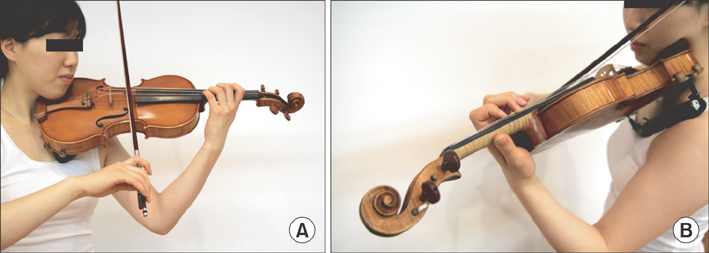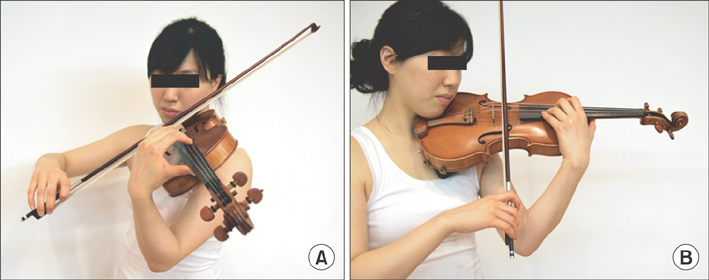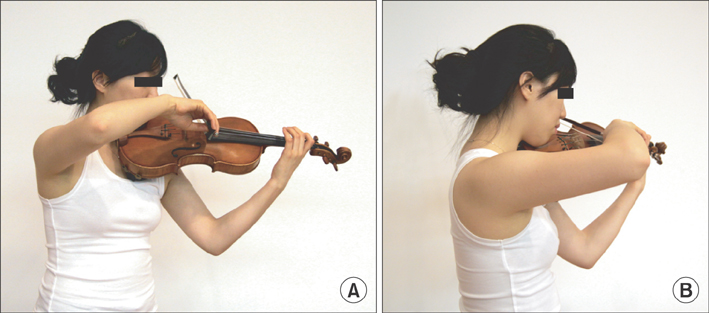Clin Orthop Surg.
2013 Sep;5(3):155-160. 10.4055/cios.2013.5.3.155.
Musicians' Medicine: Musculoskeletal Problems in String Players
- Affiliations
-
- 1Department of Orthopedic Surgery, Asan Medical Center, University of Ulsan College of Medicine, Seoul, Korea. jeonchoi@gmail.com
- KMID: 1705539
- DOI: http://doi.org/10.4055/cios.2013.5.3.155
Abstract
- There is increasing attention to medical problems of musicians. Many studies find a high prevalence of work-related musculoskeletal disorders in musicians, ranging from 73.4% to 87.7%, and string players have the highest prevalence of musculoskeletal problems. This paper examines the various positions and movements of the upper extremities in string players: 1) basic postures for holding instruments, 2) movements of left upper extremity: fingering, forearm posture, high position and vibrato, 3) movements of right upper extremity: bowing, bow angles, pizzicato and other bowing techniques. These isotonic and isometric movements can lead to musculoskeletal problems in musicians. We reviewed orthopedic disorders that are specific to string players: overuse syndrome, muscle-tendon syndrome, focal dystonia, hypermobility syndrome, and compressive neuropathy. Symptoms, interrelationships with musical performances, diagnosis and treatment of these problems were then discussed.
MeSH Terms
Figure
Reference
-
1. Roset-Llobet J, Rosines-Cubells D, Salo-Orfila JM. Identification of risk factors for musicians in Catalonia (Spain). Med Probl Perform Art. 2000; 15(4):167–174.
Article2. Sung NJ, Sakong J, Chung JH. Musculoskeletal diorders and related factors of symphony orchestra players. Korean J Occup Environ Med. 2000; 12(1):48–58.
Article3. Abreu-Ramos AM, Micheo WF. Lifetime prevalence of upper-body musculoskeletal problems in a professional-level symphony orchestra: age, gender, and instrument-specific results. Med Probl Perform Art. 2007; 22(3):97–104.
Article4. Guptill C, Zaza C, Paul S. An occupational study of physical playing-related injuries in college music students. Med Probl Perform Art. 2000; 15(2):86–90.
Article5. Koh J, Lee SJ, Kim YK, et al. The prevalence of playing-related musculoskeletal disorders of music college freshmen playing string instruments. Korean J Occup Environ Med. 2006; 18(3):189–198.
Article6. Lockwood AH. Medical problems of musicians. N Engl J Med. 1989; 320(4):221–227.
Article7. Almekinders LC. Tendinitis and other chronic tendinopathies. J Am Acad Orthop Surg. 1998; 6(3):157–164.
Article8. Yap EC. Myofascial pain: an overview. Ann Acad Med Singapore. 2007; 36(1):43–48.9. Potter PJ, Jones IC. Medical problems affecting musicians. Can Fam Physician. 1995; 41:2121–2128.10. Fry HJ. The treatment of overuse syndrome in musicians: results in 175 patients. J R Soc Med. 1988; 81(10):572–575.
Article11. Shafer-Crane GA. Repetitive stress and strain injuries: preventive exercises for the musician. Phys Med Rehabil Clin N Am. 2006; 17(4):827–842.
Article12. LeVine WR, Irvine JK. In vivo EMG biofeedback in violin and viola pedagogy. Biofeedback Self Regul. 1984; 9(2):161–168.
Article13. de Greef M, van Wijck R, Reynders K, Toussaint J, Hesseling R. Impact of the Groningen exercise therapy for symphony orchestra musicians program on perceived physical competence and playing related musculoskeletal disorders of professional musicians. Med Probl Perform Art. 2003; 18(4):156–160.14. Winspur I. Advances in objective assessment of hand function and outcome assessment of the musician's hand. Hand Clin. 2003; 19(3):483–493.
Article15. Winspur I, Parry CB. The musician's hand. J Hand Surg Br. 1997; 22(4):433–440.
Article16. Dawson WJ. Upper-extremity problems caused by playing specific instruments. Med Probl Perform Art. 2002; 17(3):135–140.
Article17. Fry HJ. Overuse syndrome in musicians: prevention and management. Lancet. 1986; 2(8509):728–731.
Article18. Semple JC. Tenosynovitis, repetitive strain injury, cumulative trauma disorder, and overuse syndrome, et cetera. J Bone Joint Surg Br. 1991; 73(4):536–538.
Article19. Kurppa K, Waris P, Rokkanen P. Peritendinitis and tenosynovitis: a review. Scand J Work Environ Health. 1979; 5:suppl 3. 19–24.
Article20. Parry CB. Managing the physical demands of musical performance. In : Williamon A, editor. Musical excellence: strategies and techniques to enhance performance. New York: Oxford University Press;2004. p. 41–60.21. Lim VK, Altenmuller E, Bradshaw JL. Focal dystonia: current theories. Hum Mov Sci. 2001; 20(6):875–914.
Article22. Altenmüller E. Focal dystonia: advances in brain imaging and understanding of fine motor control in musicians. Hand Clin. 2003; 19(3):523–538.
Article23. Schuele S, Lederman RJ. Long-term outcome of focal dystonia in string instrumentalists. Mov Disord. 2004; 19(1):43–48.
Article24. Jabusch HC, Altenmuller E. Focal dystonia in musicians: from phenomenology to therapy. Adv Cogn Psychol. 2006; 2(2-3):207–220.
Article25. Quarrier NF. Is hypermobility syndrome (HMS) a contributing factor for chronic unspecific wrist pain in a musician? If so, how is it evaluated and managed? Work. 2011; 40(3):325–333.
Article26. Brandfonbrener AG. Joint laxity and arm pain in a large clinical sample of musicians. Med Probl Perform Art. 2002; 17(3):113–115.
Article27. Winspur I, Parry CB. The musician's hand: a clinical guide. London: Martin Dunitz;1998. p. 89–93.28. Charness ME, Ross MH, Shefner JM. Ulnar neuropathy and dystonic flexion of the fourth and fifth digits: clinical correlation in musicians. Muscle Nerve. 1996; 19(4):431–437.
Article29. Ross MH, Charness ME, Lee D, Logigian EL. Does ulnar neuropathy predispose to focal dystonia? Muscle Nerve. 1995; 18(6):606–611.
Article30. Blum J. The musician's hand: aspects of music physiology and performing arts medicine. Handchir Mikrochir Plast Chir. 2000; 32(5):299–310.
- Full Text Links
- Actions
-
Cited
- CITED
-
- Close
- Share
- Similar articles
-
- Electrodiagnostic Study on Neuropathies in String Players
- Musculoskeletal Disorders and Related Factors of Symphony Orchestra Players
- Clinical Manifestations of Overuse Injury in Musicians
- A Study of Voice Disorder of Professional Voice Users
- Electromyogram-guided Botox Treatment for Focal Dystonia in a Pianist's Hand




